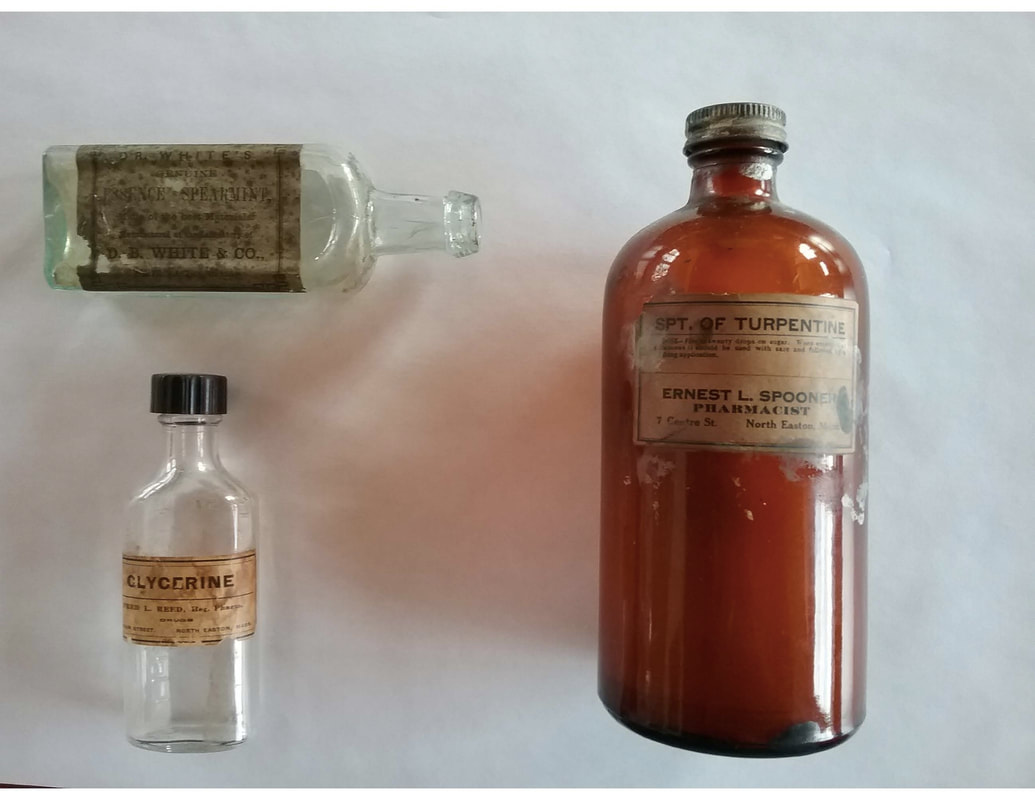|
Hello my fellow history lovers! Looking back at this weekend in history, we can all remember the great Blizzard of 1978 that covered the area with more snow than I care to see again! Going back a bit further, another blizzard hit the area in 1940, with snow and near-hurricane force winds. Eerily similar to the 1978 event, both storms stranded people in their cars, and at Boston Garden too. Valentine’s Day suffered, for last-minute shoppers were soon snowed out of candy and gift stores for a few days. Fortunately, we do not see a storm of those proportions bearing down on us this year.
This is also flu season, though the pandemic has made it a very quiet one for that illness. Mask wearing, social distancing, sanitizing and staying close to home has practically stopped the transmission of the flu virus, a welcome side effect of all the precautions we are taking because of Covid. One of the collections at the Museum that receives a lot of interest is our collection of old bottles. Today we will take a look at three medicine bottles from some years ago. *Note: for historical purposes only - not for medical advice! First, and oldest of the group, is the bottle at the top left in the attached photo. It contains "Dr. White’s Genuine Essence of Spearmint." The bottle, which features a pontil on the bottom, dates to the Civil War era (1850 – 1870) and has a paper label. On the label is the guarantee that the contents are “Made of the best Material” and that it is “Manufactured in the Laboratory of D. B. White & Co., of South Easton, Mass.” Essence of Spearmint, like other mint oils, was used to treat many symptoms ranging from stomach ills and indigestion, soothing skin irritations, and relieving tension headaches when a few drops were rubbed onto your forehead and temples. Treatments such as these are still in use and I know a number of people who keep mints in their pocket to soothe an upset stomach. Mint oils are used in aromatherapy today. Unfortunately, I have no information on our Dr. White. I strongly suspect that he lived on Turnpike Street in the area between High and Hill Streets, as the 1855 and 1871 maps show a strong presence of the White family there. D. B. White (if he was actually a doctor at all) does not show up on these maps, nor does a laboratory or other shop where this could have been produced. His lab could have been no more than a room in his house. D. B. White does not appear in any cemetery records that I have, so he remains an enigma. The second bottle is more recent, and appears below the one just mentioned. This bottle of glycerine was sold by Fred L. Reed, Registered Pharmacist. His store was located at 55 Main Street, North Easton. This bottle has a screw on cap made of bakelite, and dates from the early 20th Century. The paper label does not contain a phone number, a hint of its age. Glycerine, still widely used today as an ingredient used to keep toothpaste and other topical creams from drying out, is also the main ingredient in nitroglycerine! Yes, that same nitroglycerine that goes “Bang!” is a drug that is given to many heart patients, which when ingested, opens arteries to relieve angina pain. In former days, it was used to treat glaucoma, skin irritations, and to relieve constipation. I could not find out much at all about our friendly pharmacist. Perhaps one you might know something about him? Lastly, I call your attention to the large brown bottle on the right. Ernest L. Spooner (1868-1951) is someone we are more familiar with. As a young man, he clerked for George G. Withington who ran a pharmacy on Center Street for many years. When Withington retired, Spooner bought the business. Similar to Withington, the store supplied medicines for prescriptions, commercially produced home remedies, and sundries (everything from note paper and cards to gifts for all occasions) as do today’s drug stores. This brown bottle (whose coloring may have protected the contents from the effects of sunlight) has a metal screw cap and dates to the early 20th century. The paper label reads “Spirit of Turpentine” and “Ernest L. Spooner, Pharmacist, 7 Centre Street, North Easton, Mass.” It does not contain a telephone number. Spirit of Turpentine was used as a liniment for burns and other skin issues. The dosing directions are printed on the label, are as follows: “Five to twenty drops on sugar. When employed as a liniment, it should be used with care and followed by a soothing application.” The “drops on sugar” got my attention. It turns out that the same compound used to thin paint (this particular bottle has white paint on it) was once used to treat everything from mood swings to rheumatism, stomach upset, and chronic fatigue. Thankfully medicine has come a long way! Stay well (especially after reading this!) and until next week, Frank
0 Comments
Your comment will be posted after it is approved.
Leave a Reply. |
Author
Anne Wooster Drury Archives
June 2024
Categories |
Easton Historical Society and Museum
PO Box 3
80 Mechanic Street
North Easton, MA 02356
Tel: 508-238-7774
[email protected]

